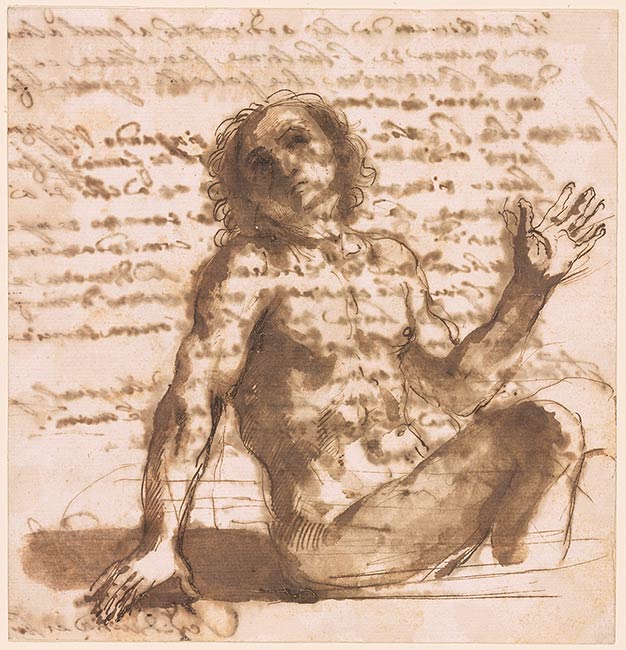
Watermark: heraldic mountain of three peaks surmounted by a bird within a circle (close to Heawood 161). Watermark, Beta radiograph
Executed on the verso of a letter referring to a portrait which is nearly finished, lacking only the last brush strokes and the varnish.
Study for Guercino's lost painting of the Death of Seneca.
This drawing, sketched on the back of a letter, must relate to one of the two half-length paintings of the death of Seneca that Guercino completed in 1643: one, described as a Seneca svenato (a bleeding Seneca), for Cardinal Antonio Barberini, and the other, described just as a half-length dying Seneca, for Marcantonio Eugeni, a Roman lawyer. As Turner has noted, there are two groups of drawings that likely correspond to the two canvases. The first set (Louvre inv 6891 and Teylers Museum, inv. H 091 and H 092; see van Tuyll, Italian Drawings of the Seventeenth and Eighteenth Centuries in the Teyler Museum, 2021, nos. 375-76) shows Seneca standing in the bath with blood spurting from his arms, thus probably relating to the Barberini painting, which is likely recorded in a copy by Guercino's workshop in Palazzo Corsini, Rome. The second group of drawings, which includes the present sheet and a drawing in the Accademia, Venice (inv. 250), shows Seneca seated in the bath, presumably having cut his wrist, but without the dramatically spurting blood; this set was probably related to the painting for Eugeni, which has been lost. Guercino would from time to time use the back of a letter or letter draft for a compositional sketch. In this case, the page has been trimmed and laid down, so a complete transcription is not possible, but the readable text refers to a portrait that was nearly finished and needed only last touches and varnish: il suo ritratto da lei a ordinatolo, al qual a [illegible] / non manche che l'ultime penellate et [illegible] / darla la vernice. Turner notes that Guercino produced very few portraits at this point in his career and suggests that the letter might refer to a lost portrait of Cardinal Donghi recorded in the "Libro dei Conti" in February 1644. Another possibility is that the letter refers to a portrait Guercino sent to Colonello Dionigi in Rome shortly after receiving final payment in January 1644; Turner argues that this painting is the Portrait of a man with a helmet in a private collection. -- Catalog entry: Guercino : virtuoso draftsman, Morgan Library & Museum, 2019, p. 88.
Kaplan, Alice M., 1903-1995, former owner.
Marciari, John. Guercino : virtuoso draftsman. New York : Morgan Library & Museum, in association with Paul Holberton Publishing, 2019, no. 25, repr.
Stone 1991a, 220; Turner 2017, 580.
Ryskamp, Charles, ed. Sixteenth Report to the Fellows of the Pierpont Morgan Library, 1969-1971. New York : Pierpont Morgan Library, 1973, p. 115.
